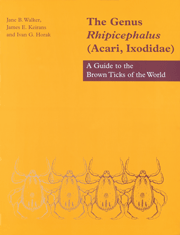Book contents
- Frontmatter
- Contents
- Acknowledgements
- 1 Introduction
- 2 Relationships of the ticks (Ixodida) and definition of the genus Rhipicephalus
- 3 Format for the accounts of individual species
- 4 Glossary
- 5 Rhipicephalus species names of the world
- 6 Rhipicephalus species occurring in the Afrotropical region
- 7 Accounts of individual species occurring in the Afrotropical region. pages 59 to 277
- Accounts of individual species occurring in the Afrotropical region. pages 278 to 490
- 8 Host/parasite list for the Afrotropical Rhipicephalus species
- 9 Rhipicephalus species occurring outside the Afrotropical region
- 10 Accounts of individual species occurring outside the Afrotropical region
- 11 Host/parasite list for the non-Afrotropical Rhipicephalus species
- 12 Species groups based on the immature stages
- 13 The transmission of tick-borne diseases of animals and humans by Rhipicephalus species
- Index
12 - Species groups based on the immature stages
Published online by Cambridge University Press: 05 November 2011
- Frontmatter
- Contents
- Acknowledgements
- 1 Introduction
- 2 Relationships of the ticks (Ixodida) and definition of the genus Rhipicephalus
- 3 Format for the accounts of individual species
- 4 Glossary
- 5 Rhipicephalus species names of the world
- 6 Rhipicephalus species occurring in the Afrotropical region
- 7 Accounts of individual species occurring in the Afrotropical region. pages 59 to 277
- Accounts of individual species occurring in the Afrotropical region. pages 278 to 490
- 8 Host/parasite list for the Afrotropical Rhipicephalus species
- 9 Rhipicephalus species occurring outside the Afrotropical region
- 10 Accounts of individual species occurring outside the Afrotropical region
- 11 Host/parasite list for the non-Afrotropical Rhipicephalus species
- 12 Species groups based on the immature stages
- 13 The transmission of tick-borne diseases of animals and humans by Rhipicephalus species
- Index
Summary
The oft-quoted saying ‘a picture is worth a thousand words’ is particularly apt when applied to the immature stages of ticks of the genus Rhipicephalus. Their identification to species level is especially difficult as several of them are so similar in appearance. For this reason we have not attempted to produce keys for their identification. Instead we have included a series of figures in which line drawings of the capitula of nymphs and larvae of morphologically similar species have been grouped. In some contentious cases, but not all, we have been influenced by the morphology of the adults in deciding on our groupings. The diagnostic characters on the capitula of the various species within a group are easily visible in these figures and should assist readers to identify them. In addition brief descriptions of these characters have been given for each group as well as summaries of the geographic distributions of the individual species.
The classification proposed now represents a revision and extension of that initially suggested by Walker (1961). We do not, however, wish to give readers the impression that we regard the present groups as being immutable. Some do appear to be naturally well founded, e.g. the R. evertsi group, comprising R. bursa, R. evertsi and R. glabroscutatum. These three species are not only very much alike morphologically at the immature stage but they are the only species in the genus at present known to have a two-host, rather than a three-host, life cycle. In other cases, though, our placing of individual species in this group or that may be regarded as questionable, e.g. the inclusion of R. armatus in the R. appendiculatus group.
- Type
- Chapter
- Information
- The Genus Rhipicephalus (Acari, Ixodidae)A Guide to the Brown Ticks of the World, pp. 591 - 609Publisher: Cambridge University PressPrint publication year: 2000



